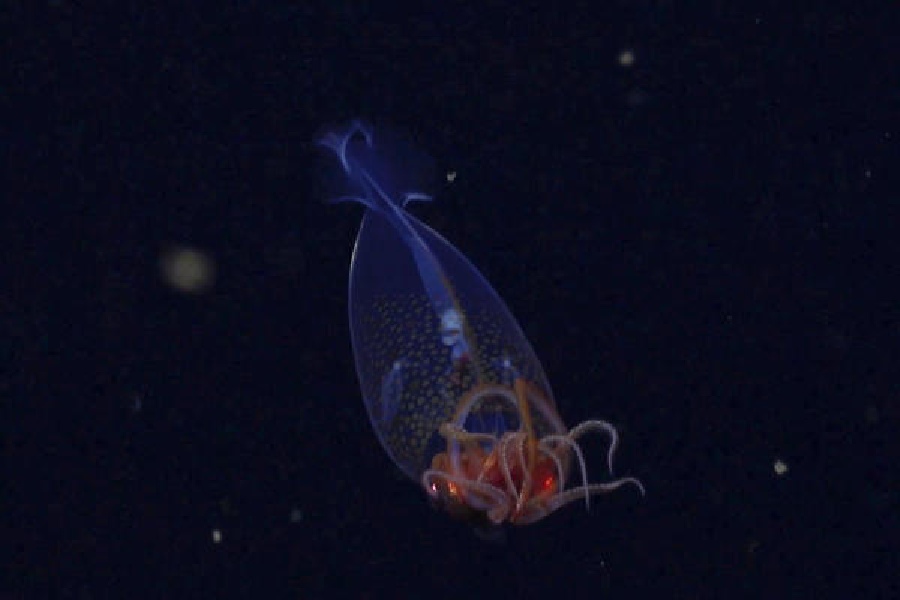In March, Kat Bolstad returned from an Antarctic expedition where she had used a new camera system specially built to search for the elusive colossal squid. No one had captured footage of one of these animals swimming in the deep sea. She didn’t spot one on this voyage either.
On the day she left the ship, though, Bolstad, a deep sea cephalopod biologist, learned about a recent video. A team searching for new marine life and remotely using a Schmidt Ocean Institute — a non-profit based in California, US — submersible in the South Sandwich Islands, had chanced upon a young cephalopod. The juvenile was about 30 centimeters long (a little less than a foot), with a transparent body, delicate arms and brown spots. It was a colossal squid.
“Pretty much as soon as I saw the footage, I knew there was a good chance,” said Bolstad, who works at the Auckland University of Technology in New Zealand. She consults remotely for Schmidt’s Antarctic work.
It’s been 100 years since the colossal squid was formally described in a scientific paper. In its adult form, the animal is larger than the giant squid or any other invertebrate on Earth, and can grow 6-7 metres long , or up to 23 feet.
Scientists’ first good look at the species in 1925 was incomplete — just arm fragments from two squid in the belly of a sperm whale. Adults are thought to spend most of their time in the deep ocean.
A full-grown colossal squid occasionally appears at the ocean’s surface, drawn up to a fishing boat while it’s “chewing on” a hooked fish, Bolstad said. Younger specimens have turned up in trawl nets.
Yet until now, humans had not witnessed a colossal squid at home, swimming in the deep Antarctic sea. One reason they’re so elusive is the sheer size of that home. Additionally, the squid are probably avoiding us, Bolstad said. “They’re very aware of their surroundings because any disturbance in the water column around them might mean a predator.”
Sperm whales, the squid’s main predator, can dive up to 2 kilometres. Perhaps to help them avoid the whales, colossal squid have evolved the world’s largest eyes — bigger than a basketball.They also have “a unique combination of suckers and hooks on the arms and the tentacles,” Bolstad said, which is how she was able to confirm that the creature in the new footage was a colossal squid.
The footage was taken by a remotely operated submersible called SuBastian, which the Schmidt Ocean Institute uses to explore the deep sea. The submersible stopped for a few minutes on descent to film the small, transparent cephalopod.
“I think it’s very exciting,” said Christine Huffard, a biologist at the Monterey Bay Aquarium Research Institute in California, US, who wasn’t involved in the expedition. Huffard has used other remotely operated submersibles in her research. She said these exploratory missions have “tremendous value”. Capturing footage of rarely seen marine animals like the colossal squid, Huffard said, can also inform decisions about human activities like deep-sea mining.
She said it would help to know where these animals spend their time, where they travel to mate or spawn, or how long they live.
The young colossal squid in the video was swimming around 600 metres down, Bolstad said, not in the deeper waters where adults likely dwell. Other deep-sea squids spend their early lives in shallower waters, she said. Having a transparent body may help the baby swim undetected by predators before it descends as an opaque, reddish adult to the darker ocean.
A submersible’s camera can detect the squid — and transmit images instantaneously. Unlike the scientists of a century ago, who had to dig through partly digested carnage in a whale’s belly, anyone could watch the Schmidt “dive-stream” from home to be part of the moment of finding the colossal squid. Bolstad said, “To be able to participate in these explorations in real time, from anywhere on the planet — that’s an amazing thing that humans can do.”
She’ll continue looking for a full-grown animal. “I can’t wait to see what a live adult colossal squid looks like, at home in the deep sea where it belongs,” she said.










